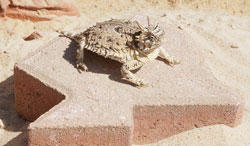Walking around TCU, the horned frog is everywhere. But outside of this campus, they are becoming more difficult to find.The TCU mascot and official state reptile of Texas is at risk of becoming an endangered species. The Texas horned lizard is listed as a threatened species by the state of Texas, according to the Fort Worth Zoo Web site.
“That means that it is illegal to possess, collect or even harass a Texas horned lizard. They do not do well in captivity and seldom live long when taken out of their natural environment,” according to the Web site.
If anyone sees a horned lizard in the wild, he or she should look at it but not touch it, according to the Web site.
Ellen Schwaller, senior environmental science major, is writing her senior honors thesis on the horned frog, which is actually called the horned lizard. She said the population of the horned lizard has depleted greatly in the past five decades.
“In the past, they were actually found on TCU’s campus,” Schwaller said. “Now you have to drive quite a bit to find one around.”
Tony Burgess, professor of environmental studies, is in charge of this project. He said he grew up down the street from TCU where horned lizards used to be seen everywhere.
“I remember seeing horned lizards all over the place when I was growing up,” he said. “Now they are nowhere to be found in this area.”
Through this research, Schwaller said, they are trying to fill in the holes in the research so they can ask the right questions when assessing a possible reintroduction of the horned lizard into the Fort Worth area.
Schwaller said there are two possible theories on horned lizard depletion. The first theory centers on the climate changes.
Horned lizards survive better in dry climates and in the past few years, this area has become wetter and their population has condensed.Burgess said horned lizards are doing fine in West Texas, but the climate there remains dry, unlike Central and North Texas.
The other theory, Schwaller said, is that the harvester ant is the main diet of the horned lizard. But the red fire ants have migrated north from South America and overtaken some of the harvester population. With fewer ants, the horned lizard population has decreased.
“The fire ants may kill the horned frog,” he said. “Or they may out-compete the harvest ant leaving the frog nothing to eat or the spray they use to control fire ants may kill the fire ants. There is still a lot of research left to be done.”
Burgess said before they can really start focusing on the horned lizard, they must first understand the ant population and habitation. They will start by counting the ants and observing their diets.
Remekca Owens, Communications Manager for the Fort Worth Zoo, said that the zoo has had success breeding the horned lizard. Their first hatching was in 2005. In 2006, she said, the zoo successfully bred 25 horned lizard hatchings.
The zoo currently has one adult horned lizard on exhibit in the Mountains and Desert region of the Texas Wild! exhibit, Owens said. The other adults and juvenile horned lizards are kept in an off-exhibit area at the zoo.
Owens said, “The zoo hopes to organize a horned lizard release project with Texas Parks and Wildlife Department in the near future.”
TCU students and fellow researchers will continue to try to help the horned lizard be able to survive in the this area, Schwaller said.

